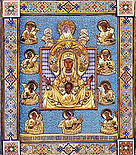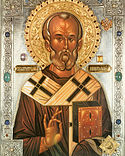Nativity Epistle of Bishop Andrei of Yarraville, Australia and New Zealand
Nativity Epistle to the clergy and parishioners of the Australian-New Zealand Diocese of ROCA
“Great is the mystery of godliness: God was manifested in the flesh.” (1 Tim. 3:16).
Dear fathers, brothers, mothers and sisters,
We are now celebrating the Nativity of Christ, the appearance of the Son of God in the flesh. Holy Apostle Paul speaks about this astonishing mystery thus: “Great is the mystery of godliness: God was manifested in the flesh.” (1 Tim. 3:16).
Church feasts are not only remembrances of historical events; it is a real communion with the mystery of Christianity. We draw near to this mystery of godliness every time the Divine Liturgy is performed. During the Eucharist, the same body of Christ that was born of the Most-Holy Virgin Mary lies on the Holy Table. The Altar at that moment represents the cave where Christ was born, and the paten – the manger where He was placed.
The Son of God abided, in the flesh, in the womb of the All Blessed Virgin Mary – “O Theotokos, thou didst bear in thy womb, according to the flesh, the pre-eternal and unapproachable One, Who is One of the unmingled Trinity, according to godhead” (Sedalen after the 2nd Kathisma) – the Church sings.
But He too resides spiritually in the heart of every Orthodox Christian that believes in Him, and especially those that lovingly partake of Holy Communion. He enters into the closest communion with them as He Himself said: “He who eats My flesh and drinks My blood abides in Me, and I in him.” (John 6:36).
Let us endeavour to immerse ourselves in the mystery of our faith, so that we may view the performing mystery not only with physical eyes, but to penetrate its spiritual meaning through spiritual vision. Let us leave the visible and live in the spiritual world, which is not far from us, as it is in our hearts.
Let us “not look at the things which are seen, but at the things which are not seen. For the things which are seen are temporary, but the things which are not seen are eternal.” (2 Cor. 4:18). Everything that originates in this visible world – although real – is temporary and changeable, while the spiritual world, even though it is invisible and therefore appears non-existent, is unchangeable and eternal.
In this world, the darkness of sin and disbelief is solidifying. From this, it becomes quite clear that the dreadful Second Coming of Christ is drawing near. It will be distinctly different to His first coming in the humble image of a newly-born Infant. At the end of time, the Lord will come in all His Father’s glory with His Angels to judge the world.
As to the time of His Coming, the Lord gives the following illumination: “Now when these things begin to happen, look up and lift up your heads, because your redemption draws near.” (Luke 21:28). This, in effect, means that we must tear our thoughts and heart away from earthly cares and direct them toward heaven, from where we expect the Lord to come.
From the Holy Scripture, we know that the Church of Christ will exist up to the end of this world; but at that time, the true Church will be so small that it would appear that She doesn’t exist. We can already observe the fulfilment of this prediction.
Nevertheless, irrespective of all obstacles, we must labour according to our abilities in expanding and developing the Church and the Lord Almighty will crown our efforts with success. However, even if due to the lack of faith in the world our labours remain ineffective, we at least will not be judged as lazy servants.
I greet all of you with the great feast of the Nativity of Christ.
Bishop Andrei.
Nativity 2018 / 2019.

